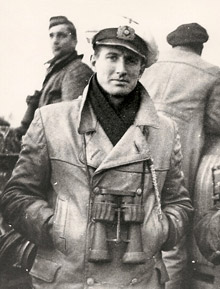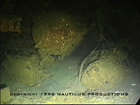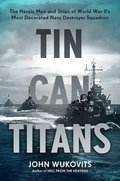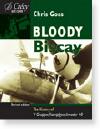The Junkers Ju-88
prepared by Emmanuel Gustin
The Junkers Ju 88 was one of the most versatile and effective combat aircraft of World War II. Its closest counterparts on the Allied side were the Mosquito and Beaufighter. The German aircraft was larger and slower, but nevertheless very effective. 14,676 were built, including a staggering 104 prototypes for its 60 different versions.
Like the Mosquito, the Ju 88 originated as a fast bomber. In 1935 the Luftwaffe had a requirement for a so-called Schnellbomber, which should have a speed of 500km/h with 800kg of bombs. This was much faster than the biplane fighters that then equipped the German fighter units; it was even faster than the first models of the Bf 109 monoplane fighter. For this ambitious goal Henschel proposed the Hs 127, Messerschmitt the Bf 162, and Junkers submitted the designs Ju 85 and Ju 88. Later the Bf 162 achieved some fame when it appeared on German propaganda postcards, but this was disinformation, and the real winner was the Ju 88.
Chief designer was Ernst Zindel. The first prototype (Ju 88V1) made its first flight on 21 December 1936. The Ju 88V1 had an all-metal, stressed skin construction; Junkers hired two American engineers to acquire knowledge about the latest structural developments. The Ju 88V1 had a compact, well-streamlined cockpit roof and a pointed nose. It was powered by Daimler-Benz DB 600 engines, installed in cowlings with circular radiators. The inverted V-12 engines were installed in front of the wing leading edge, not under the wing. Because of the long cowlings the Ju 88 earned the nickname Dreifinger, three fingers. The Ju 88V1 was lost before performance tests could begin, but the type had already shown great promise.
From the third prototype onwards the engines were changed to Junkers Jumo 211, because the scarce Daimler-Benz engines were reserved for fighters. The fourth prototype, the Ju 88V4, featured the "beetle eye" cockpit of the production aircraft, a four-seat cockpit covered with a large number of small, flat transparencies. It also had the ventral gondola under the nose, from which a gunner could fire rearwards. In contrast, the Ju 88V5 was completed with a maximum of streamlining, and on 9 March 1939 it set a closed-circuit record by flying 1000km with 2000kg of load at an average speed of 517km/h. It was a sensational public debut.
Meanwhile, the general staff of the Luftwaffe made some fateful decisions. On the one hand the Ju 88 was given the highest possible priority, with increasing concern expressed as the war came nearer and production still remained behind schedule. On 15 October 1939 Dr. Heinrich Koppenberg was put in charge of it, and given the authority to requisition any production facilities he needed; but the results were still disappointing. On the other hand the Luftwaffe had requested that the Ju 88 would be converted into a dive bomber. This inevitably slowed down the development and reduced flight performance. Installing dive brakes under the wing was the smallest problem: The need to reinforce the structure for dive bombing attacks caused a considerable increase in weight. Larger internal bomb bays and external bomb racks for four 500kg bombs increased the problems, and when the first production aircraft came off the line in August 1939, a number of restrictions had to be imposed. Even after all necessary modifications had been carried out, pilots did not usually achieve dives steeper than 60 degrees, although the excellent flying characteristics and automatic dive bombing equipment of the Ju 88 did not make such attacks particularly difficult. But there was little operational need for dive-bombing, except for anti-shipping missions.
The Ju 88 was certainly an excellent aircraft. It was easy to fly, gentle, responsive, and manoeuverable, without vices. These were the characteristics which also made it an excellent nightfighter. A point of criticism for allied test pilots was the cockpit. The extensive framing of the many panels resulted in a fairly restricted view. In the bomber versions it was also rather cramped and inefficient, although the close grouping of the crew made communication easier.
The War breaks out ...
When the war broke out the Ju 88 was an excellent bomber, but only a handful were available and production was not more than one per week. Just one Gruppe was equipped with Ju 88s. In the third week of the war four Ju 88A-1s attacked British warships at Scapa Flow, but they caused no damage. A Ju 88 had the dubious honour to be the first German victim of RAF fighters, on 9 October 1939, but nevertheless the RAF recognised it as the most formidable bomber of the time. The most important bomber version was the Ju 88A-4, with longer span wings, a stronger airframe, and Jumo 211J engines. It appeared in the summer of 1940. The strong points of the Ju 88 were speed and a significant bomb load. Its weak points were its short range (this was often extended by carrying additional fuel tanks in the bomb bays), a cramped and inefficient cockpit, and poor defensive armament. During the Battle of Britain the Ju 88 proved that it was the best German bomber, but operations from bases in Norway, without fighter escort, still resulted in heavy losses. And as the fight progressed, a shortage of trained bomber crews became apparent.
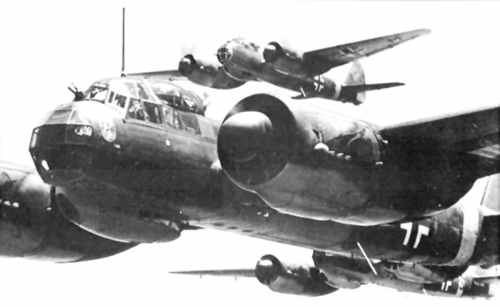
3 Junkers Ju-88A-4 bombers.
Note the "beetle eye" cockpit glazing and the ventral gondola with gun position.
The more streamlined Ju 88B series did not enter production, but was developed into the Ju 188, the successor of the Ju 88. But in 1942 a new attempt was made to increase the speed of the Ju 88. The resulting Ju 88S had a well-streamlined glass nose, and BMW 801 radial engines or Julmo 213 in-line engines with more power the Jumo 211. On most aircraft no external bomb racks were fitted, the ventral gondola was often removed, and armour was reduced. This increased speed to 612km/h, much faster than most other bombers of the war.
Meanwhile, a very different line of development had begun. The Reichsluftfahrtsministerium (RLM) had granted Junkers permission to pursue, at low priority, the development of a heavy fighter-bomber version. This became the Ju 88C. The transparent bomber nose was replaced by a metal nose cap, containing at first three 7.92mm machineguns and one 20mm cannon -- a relatively modest armament, but many models could carry two more 20mm cannon in the gondola under the nose. There also were a lot of variations in defensive armament. The Jumo 211 engines were retained, because the Ju 88C had too low a priority to get the desired BMW 801 radials. The first production model, Ju 88C-2, retained bomb bays, and it operated as a long-range coastal patrol aircraft, initially flying anti-shipping strikes from bases in Norway. Soon the Ju 88C-4 appeared and its roles were extended to include night attacks on British airfields, ground attack missions, flying escort for transport aircraft, and providing air cover for convoys.
Supporting the U-boats
The standard fighter version became the C-6, including experience acquired with the A-4 bomber, and the same Jumo 211J engines. The C-6 was used mostly as fighter-bomber, and therefore assigned to bomber units. As a reaction to the increasing number of attacks on German shipping, especially on U-boats, in the Bay of Biscay, KG40 started flying anti-shipping patrols and escort missions from bases in France, in September 1942. They were a significant threat to the antisubmarine aircraft, much more efficient than the mixture of Ar 196 floatplanes, short-range fighters and Ju 88 bombers which had earlier operated over the Bay of Biscay. But aircraft such as the Sunderland flying boat, although slow and operating alone, were not easy targets. The Germans attacked them in small formations, not alone, and even then they found that the sturdy, well-armed flying boats were hard to shoot down. On the other hand the Ju 88s had to escort Fw 200 patrol aircraft until they were beyond the reach of land-based fighters. Allied losses increased, and the British countered by sending out Beaufighters over the Bay of Biscay, and later Mosquitos; the Germans threw Focke-Wulf Fw 190 single-seat fighters in the battle, with long-range fuel tanks. The fight was most intense in the summer of 1943. However, the Germans were on the losing side. And after the allied invasion in Normandy, KG40 was quickly destroyed in a number of desparate attacks on the landing beaches; and in July 1944 the unit was disbanded.

A Ju 88P anti-tank aircraft.
For a fighter the Ju 88C had a more than generous size, but this enabled it to carry both powerful armament and extensive electronic equipment. Hence it was an obvious candidate for conversion to a nightfighter. Initial operations were conducted without radars, but in late 1942 some Ju 88C-6 fighters received the Lichtenstein BC radar, later replaced by Lichtenstein C-1 and in late 1943 by Lichtenstein SN-2. Although the Messerschmitt Bf 110 remained the most numerous nightfighter, the Ju 88C took an increasing part; it was well-liked, but actually too slow for this role. In early 1943 enough BMW 801 engines were finally available, and version of the Ju 88C with these was known as the Ju 88R. On 9 May 1943 a Ju 88R-1 defected to Britain, landing near Aberdeen. Allegedly it was carrying an important agent, but the secrets of its Lichtenstein BC radar were also extremely valuable. This Ju 88R-1, in the RAF museum at Hendon, is one of the two surviving Ju 88s, the other being a Ju 88D-1 in the USAF museum.
A more extensive nightfighter development produced the Ju 88G, with extended wingtips, rectangular tail surfaces, BMW 801D engines, and four 20mm MG151/20 cannon in a a small ventral gondola. Often two more cannon were put in the fuselage, firing diagonally upwards; this so-called Schräge Musik installation was extremely effective, because the British bombers had no ventral gun positions. The Ju 88G replaced the C and R on the production lines, and became the most effective German nightfighter. This type was given high priority, and the Ju 88 production lines now delivered more fighters than bombers: In 1944 the numbers were 2518 vs. 716. But again the Luftwaffe had bad luck: On 13 July 1944 a Ju 88G-1 landed on a RAF base, after a navigation error, and gave away all the secrets of its Lichtenstein SN-2 radar, and Flensburg and Naxos radar detectors. The Ju 88G-6 had Jumo 213 engines, and this model entered service in the late 1944.
The Ju 88D, Ju 88H, and Ju 88T were reconnaissance versions. The Ju 88D was based on the A-series and the T on the S-series, but the Ju 88H was more extensively modified. The fuselage was elongated from 14.40m to 17.65m, to carry more fuel for operation far over the Atlantic. The Ju 88H-1 was intended for long-range naval reconnaissance, carrying radar. The Ju 88H-2 was a more offensive version, with six forward-firing MG151/20 cannon. The Ju 88H-3 was further extended to achieve an even longer range. Small numbers of these were built, and the Ju 88P was also rare. The Ju 88P was an anti-tank version, armed with two 37mm cannon, a 50mm cannon, or even a 75mm cannon in a ventral gondola. These aircraft were too unwieldy and the recoil was too large.
The weirdest use of the Ju 88 was as the lower half of the Mistel combinations. These used Ju 88s airframes, new-built or war-weary, of which the cockpit was removed. An enormous shaped-charge warhead was installed instead. A single-engined fighter, usually an Fw 190A, was put on top. The pilot of the fighter was to fly the entire contraption to its target, aim it, then release the Ju 88 for a dive onto its target. The fighter would fly home, its fuel tanks still full because it drew fuel from the Ju 88 on the outbound leg. The original target was the British Fleet at Scapa Flow; later it was changed to Russian powerstations. But both plans fell through and the Misteln were expended against bridges over the Oder and Neisse, in a desperate attempt to stop the Russian advance. A variation of this principle was tried with a Ju 88H-4, which was stretched to 20.38m, for long-range reconnaissance flights.
Specifications
| Ju 88A-4 | Ju 88C-6c | Ju 88G-7 | |
|---|---|---|---|
| Engines | 2 Junkers Jumo 211J-1 |
2 Junkers Jumo 211J |
2 Junkers Jumo 213E |
| Power | 1350hp | 1340hp | 1750hp |
| Wing Span | 20.00m | 20.08m | 20.08m |
| Length | 14.40m | 14.36m | 15.55m |
| Height | 4.85m | 5.07m | 4.85m |
| Wing Area | 54.50m2 | 54.50m2 | 54.50m2 |
| Empty Weight | 9060kg | 9860kg | |
| 12350kg | 13110kg | ||
| Max. Weight | 14000kg | 14674kg | |
| Max. Speed | 470km/h at 5300m | 494km/h at 5300m | 626km/h at 9100m 435km/h at S/L |
| Ceiling | 8200m | 8850m | |
| Climb | 9850m in 26.4min | ||
| Range | 2730km | 2940km | |
| Armament | One 13mm MG131 or two 7.92m MG81 in the nose; two MG81 in the rear of the cockpit, two MG81 in the ventral gondola. Up to 2000kg of bombs. | Three 7.92mm and three 20mm MG FF cannon in the nose. Two rearwards-firing MG131 or MG81 guns. Up to 500kg of bombs. | Four 20mm MG 151/20 cannon in ventral pod, two upward firing MG151/20, one aft-firing 13mm MG131. |
Sources
- Wings of the Luftwaffe
Eric M. Brown
Pilot Press, 1977. - Junkers Ju 88 in action, part 2
Brian Filley
Squadron/Signal Publications, 1991. - Tangmere Summer
Roland Beamont
in Aeroplane Monthly, October 1993. - The Ones That Got Away
Chris Goss
in Flypast, October 1995. - Uncle Sam's Baksheesh
Danut Vlad
in Air International, October 1994 - Airplane Nr.56
Selected media links
|
